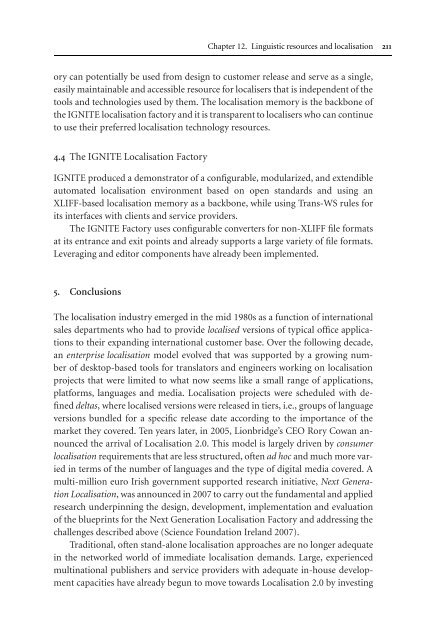Topics in Language Resources for Translation ... - ymerleksi - home
Topics in Language Resources for Translation ... - ymerleksi - home
Topics in Language Resources for Translation ... - ymerleksi - home
- No tags were found...
You also want an ePaper? Increase the reach of your titles
YUMPU automatically turns print PDFs into web optimized ePapers that Google loves.
Chapter 12. L<strong>in</strong>guistic resources and localisation 211ory can potentially be used from design to customer release and serve as a s<strong>in</strong>gle,easily ma<strong>in</strong>ta<strong>in</strong>able and accessible resource <strong>for</strong> localisers that is <strong>in</strong>dependent of thetools and technologies used by them. The localisation memory is the backbone ofthe IGNITE localisation factory and it is transparent to localisers who can cont<strong>in</strong>ueto use their preferred localisation technology resources.4.4 The IGNITE Localisation FactoryIGNITE produced a demonstrator of a configurable, modularized, and extendibleautomated localisation environment based on open standards and us<strong>in</strong>g anXLIFF-based localisation memory as a backbone, while us<strong>in</strong>g Trans-WS rules <strong>for</strong>its <strong>in</strong>terfaces with clients and service providers.The IGNITE Factory uses configurable converters <strong>for</strong> non-XLIFF file <strong>for</strong>matsat its entrance and exit po<strong>in</strong>ts and already supports a large variety of file <strong>for</strong>mats.Leverag<strong>in</strong>g and editor components have already been implemented.5. ConclusionsThe localisation <strong>in</strong>dustry emerged <strong>in</strong> the mid 1980s as a function of <strong>in</strong>ternationalsales departments who had to provide localised versions of typical office applicationsto their expand<strong>in</strong>g <strong>in</strong>ternational customer base. Over the follow<strong>in</strong>g decade,an enterprise localisation model evolved that was supported by a grow<strong>in</strong>g numberof desktop-based tools <strong>for</strong> translators and eng<strong>in</strong>eers work<strong>in</strong>g on localisationprojects that were limited to what now seems like a small range of applications,plat<strong>for</strong>ms, languages and media. Localisation projects were scheduled with def<strong>in</strong>eddeltas, where localised versions were released <strong>in</strong> tiers, i.e., groups of languageversions bundled <strong>for</strong> a specific release date accord<strong>in</strong>g to the importance of themarket they covered. Ten years later, <strong>in</strong> 2005, Lionbridge’s CEO Rory Cowan announcedthe arrival of Localisation 2.0. This model is largely driven by consumerlocalisation requirements that are less structured, often ad hoc and much more varied<strong>in</strong> terms of the number of languages and the type of digital media covered. Amulti-million euro Irish government supported research <strong>in</strong>itiative, Next GenerationLocalisation, was announced <strong>in</strong> 2007 to carry out the fundamental and appliedresearch underp<strong>in</strong>n<strong>in</strong>g the design, development, implementation and evaluationof the bluepr<strong>in</strong>ts <strong>for</strong> the Next Generation Localisation Factory and address<strong>in</strong>g thechallenges described above (Science Foundation Ireland 2007).Traditional, often stand-alone localisation approaches are no longer adequate<strong>in</strong> the networked world of immediate localisation demands. Large, experiencedmult<strong>in</strong>ational publishers and service providers with adequate <strong>in</strong>-house developmentcapacities have already begun to move towards Localisation 2.0 by <strong>in</strong>vest<strong>in</strong>g
















